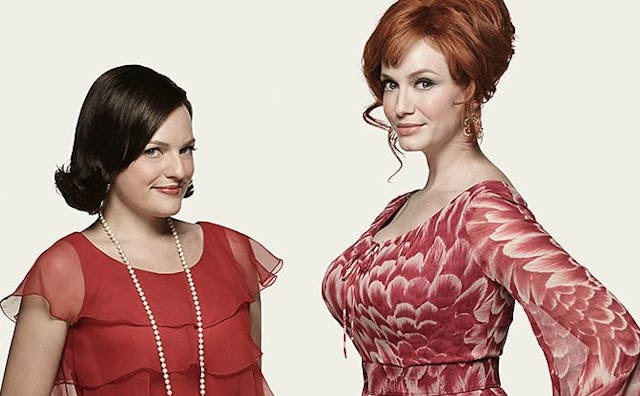The Women of 'Mad Men' Are The Characters We'll Miss Most

Mad Men was clearly misnamed. Because while we deeply love dapper Donald Draper—who doesn’t?—and adore the misdeeds of Roger, Pete, Ken, Stan, Ted, Michael and the killed-off Bert and Lane, too (notice I didn’t include Harry in this list), it’s the women we’ll truly miss.
This subtly subversive feminist show actually tricked men into watching deeply affecting female storylines under the guise of chased skirts and one-too-many martinis. Talk about the radical Sixties!
We fans of the feminine persuasion have always known that the ladies were at the heart of the tale. Here’s a roundup of Mad Men‘s main female characters, who engendered us to think of them as close confidantes—women with whom we might want to go out and have a drink—ranked in descending order of how serious our separation anxiety will be with their departure from the airwaves.
(Girlfriends, we’re gonna miss you.)
Megan
She of the gap-toothed, imperfect beauty, a woman who works a black micro-mini and purrs “Zou Bisou Bisou” like nobody’s business. Fans were first introduced to Megan as a sweet secretary-cum-nanny for Don’s kids, so her fierce insistence on a career independent of advertising—her movie-star-handsome husband’s trade—felt like a thrilling uprising of sorts. Like an older sister to Sally but a younger cousin to Peggy, Megan represents the Enjoli-perfume-wearing woman (“I can bring home the bacon … fry it up in a pan … and never, never, never let you forget you’re a man”) of the mid-1970s many of us still remember: freshly divorced, a bit wry from the experience, still young enough to have it going on, and adamantly refusing to be anything but self-actualized. Adieu to our stylish French-Canadian friend.
Betty
Oh, Betty, where do I begin? Many hate you for being such a bad mom. But I’ve always seen you as a victim of circumstance, the 1960s equivalent of the lovely, quietly conspiring May in The Age of Innocence. That character, like you, could only navigate the narrow margins she’d been given to survive in a society that valued her youth and beauty but not her brain or right to autonomy. How could Betty fail to plot her own winning hand? Yet Betty doesn’t win, can’t win, because she’s a butterfly in a jar, an object to be gazed at and trotted out like a speared trophy. She misdirects her rage from the inside of her glass trap at anyone who comes too close—her teenaged daughter, Sally, whose growing emancipation she both encourages and resents—her second husband, Henry, and herself. Her self-destructive chain-smoking, after all, is what finally finishes her off in the end. I was rooting for Betty as the “adult student” in the last few episodes. I really was. Because she was this close to graduation.
Joan
Joanie is a woman who was “raised to be admired” and who is caught between two crashing cultures. Like another, later decked-out (drag) queen, Ru Paul, she werks both. I still know women like this—who put a little booty into business—and while I admittedly raise the slightest of peaked eyebrows in their direction, I also know their sexy maneuverings are less a gaming of the system and more a fight to be seen and heard despite their good looks. Men project their fantasies onto Joan, and make all sorts of assumptions about women like her—as if breast size is an indicator of intellect and ability. When Joan decides to take matters into her own hands and prostitutes herself to a loathsome client for a partnership stake in the firm, fans both cringed and pumped their fists with empathetic empowerment. Because Joan knows this is likely her only chance at the brass ring. In an unfair world, she’ll make her own luck, thank you. And don’t you dare judge her for it. Joan, your hourglass fabulousness has been all that—but your sneering mention of Betty Friedan in last week’s episode made me hoot and holler with pride. I’d tell you to “Go, girl!”—but, damn, you’re already gone.
Sally
Young Sally is the real heartbeat of the series, and she—much more than her shape-shifting father—is the show’s true study of evolving identity. Opening when she was a girl of 7, the story follows Sally’s arc from suburban Daddy’s girl to rebellious and disillusioned teenager. Sally has come of age during turbulent times—divorced parents, assassinated leaders, civil rights riots, men on the moon—forging her as someone who holds suspect all things and everyone. No ground is secure beneath this character’s pretty feet; the old ways no longer work and have fallen to the wayside. In a few short years, the antiquated notions of what it is to be a woman have also been scrutinized and soundly rejected. There are casualties in every revolution, of course, and Sally leaves the Sixties, and the show, more than a little war-torn. Out of all the women of Mad Men, I most long to see how Sally fares.
Peggy
So much has been written about Peggy. Her abandoned baby. Her struggle to be taken seriously in a man’s world. Her drive and ambition. Her love-hate relationship with Don. (And Joan. And Pete. And Ted. And even Stan.) Peggy is prickly, for sure, but she’s also most like us modern gals: We want our talents to shine. And we’d like a smart man to love us, too. Probably in that order. And that’s OK. Peggy’s slow morphing from clueless secretary to the agency’s star copy chief is riveting precisely because it echoes our own climbs in our twenties and thirties. Ultimately, we know Peggy Olson is going to be just fine, at McCann-Erickson or elsewhere. But we’ll miss her the most. She been our BFF on Sunday nights for what feels like a generation. Bye-bye, Peggy. Now go and kick some ass.
This article was originally published on